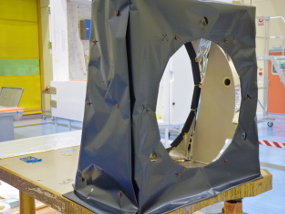#1: CHEOPS spacecraft hardware delivery
1 July 2015
This is the first entry in the CHEOPS Journal, a series of articles documenting milestones in the first small (S-class) mission of ESA's Science Programme. With a compressed schedule - only 5 years from mission selection to launch readiness - milestones in the CHEOPS project will pass by in quick succession. In this series we report on some of these and share news on project progress.Before reporting on progress we take this opportunity to provide a brief overview of CHEOPS.
 |
| Artist's impression of the CHEOPS spacecraft. Credit: ESA - C. Carreau |
The mission – the CHaracterising ExOPlanets Satellite - is the first that is dedicated to the search for exoplanet transits of bright stars already known to host planets. The mission's main science goal is to characterize the structure of planets with masses in the super-Earth (defined as planets with masses of 1-4 times that of the Earth, MEarth) to Neptune (4-10 MEarth) range that orbit bright stars. This will be achieved by combining a very precise measurement of the planet radius achieved through monitoring of the photometric output of the host star as the planet moves in front of it, with previously-measured masses, to determine the average density of the planets. A key objective will be to identify planets with significant atmospheres, thus establishing prime targets for spectroscopic characterization with the James Webb Space Telescope and future large ground-based facilities.
The scientific payload of CHEOPS comprises a single, ultra high-precision photometer operating over the 0.4 – 1.1 micron waveband, which in turn is constructed from a single 1024 x 1024 pixel back-illuminated, frame-transfer CCD sitting in the focal plane of the 33 cm physical diameter Ritchy Chrétien telescope.
CHEOPS is an ESA mission implemented in partnership with Switzerland, through the Swiss Space Office (SSO). The University of Bern leads a consortium of 11 ESA Member States contributing to the mission and represented in the CHEOPS Science Team. The mission was selected as the first ESA S-class mission at the end of 2012, adopted in June 2014 and all partners are working to a tight schedule driven by the target of achieving launch readiness by the end of 2017.
CHEOPS will operate from a Sun Synchronous Orbit, with an altitude between 650 and 800 km and a Local Time of the Ascending Node of either 6 AM (baseline) or 6 PM (back-up). The spacecraft has a total mass of approximately 280 kg and is designed to be compatible with different medium and small launch vehicles. It will be injected to its operational orbit with a shared launch.
CHEOPS is now moving steadily from a paper design to the hardware phase. Over the last couple of months the Instrument Consortium, led by the University of Bern, has taken delivery of the first hardware from Airbus Defence and Space (ADS)–Spain, the prime contractor for the CHEOPS platform. These deliveries included the Platform Simulator, as well as the platform panels for instrument assembly and handling, the Star Tracker Optical Head Assemblies with their associated multi-layer insulation (MLI), and the support structure for the Baffle Cover Assembly.
The platform simulator is a stand-alone substitute for the spacecraft and is used to verify and validate the operations of the CHEOPS instrument. As such, it replicates all electrical and functional interfaces between the instrument and the platform.
There will be two star trackers (plus two redundant heads) on CHEOPS. These will be mounted perpendicular to the line of sight of the telescope.
The Baffle and Cover Assembly is a key element of the science payload. The baffle provides the high level of straylight rejection needed to achieve the photometric precision crucial to the scientific success of CHEOPS. The protective cover prevents contamination of optical surfaces during advanced integration and launch.
As of mid-June, the Instrument Consortium is preparing for testing of the instrument structural and thermal model (I-STM), which will take place in Bern and run from mid-July to the end of August. At spacecraft level, tests will start on the structural qualification model at the end of September.
About CHEOPS
CHEOPS is an ESA mission implemented in partnership with Switzerland, through the Swiss Space Office (SSO). The University of Bern leads a consortium of 11 ESA Member States contributing to the mission and represented in the CHEOPS Science Team. ESA is the mission architect responsible for overall mission definition and procurement of the spacecraft and launch. ESA is also responsible for early operations phase that will be executed by the spacecraft contractor, EADS CASA Espacio S.L. which is part of Airbus Defence and Space. The science instrument is led by the University of Bern, with important contributions from Austria, Belgium, Germany and Italy. Other contributions to the science instrument in the form of hardware or science operations, are provided by Hungary and by France, Portugal, Sweden and the United Kingdom respectively. Following successful in-orbit commissioning of the spacecraft, responsibility for operations will be taken over by the CHEOPS Mission Consortium, with the Mission Operations Centre under the responsibility of Spain and the Science Operations Centre led by and located at the University of Geneva, Switzerland.







